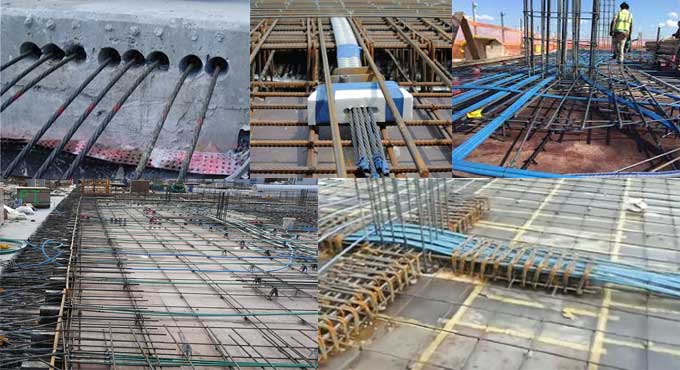NEWS | SOFTWARE | SHEET
Concrete for Construction: Post Tensioning in Cold Weather
A concrete structure can withstand its own weight owing to its compressive strength. The material lacks tensile strength, however. Due to its lack of flexibility, the structure struggles under the added weight of vehicles in a parking lot or on a bridge. The structure becomes weaker and cracks as a result.
Rebar, or steel reinforcing bars, are embedded in concrete for this reason. Although the concrete is passively reinforced with rebar, it does not bear any load or force until it has cracked. As an active reinforcement, post tensioning is useful here.
Causes of Post Tensioning
Recent decades have seen a dramatic upsurge in post-tensioned construction, especially in high rise buildings, industrial floors, and residential structures.
A large surface area slab, such as a tennis court or parking lot, is typically constructed using this technique. When something is squeezed or crushed, it is compressed; when it is tensioned, it is pulled apart. Post tensioning involves placing the concrete structure under compression in the areas where loads cause tensile stress. In order to offset this tensile stress, post tensioning is used.
In order to maintain the force in the strand throughout its life, the cables, or tendons, are pulled tight and tensioned as soon as concrete reaches a specific initial compressive strength before service loads are applied. The strands are then anchored to the outer edges of the concrete. A hydraulic jack is used to tension the tendons. Consequently, concrete slabs become stiffer and more capable of resisting tensile forces because they are actively compressed.
Define Cold Weather Concreting
In the context of cold weather, three or more consecutive days of low temperatures are defined as ambient temperatures below 40 degree Fahrenheit or 4 degree centigrade and air temperatures below 50 degree Fahrenheit or 10 degree centigrade for more than 12 hours a day. Too low and ambient temperature may cause the cement to stop or slow down hydration.
Concrete construction projects are at risk if these practices are not followed. Among them are cracking, rapid temperature changes, and decreased durability.
Tendon Deterioration Problem
Despite the protective materials that cover post-tensioned tendons, water and salts can still penetrate if the anchors of the steel tendons are not properly protected. De-icing salts are used more frequently in cold weather conditions and there is more moisture circulating in the air. A structure's service life is reduced due to corrosion acceleration.
Tendon Deterioration Solution
Structures that have deteriorated can be difficult to repair in terms of strength and serviceability. Increasing & restoring a structure's load capacity can be achieved using external post tensioning. A steel beam or a concrete beam can be used for this purpose.
To maintain a safe & serviceable structure, repairs should be performed as necessary. Maintaining the structure is the most effective way to prevent it from deteriorating. Expansion joints and seals must be protected to limit moisture, ensure adequate drainage, and provide waterproofing. Moreover, grout plugs deteriorate & tendons are mechanically damaged must ensure the structure's longevity.
An epoxy resin injection or cathodic protection of anchorages can be used if deterioration has already begun in the post tensioned structure.
Concrete Temperature Monitoring & Post Tension Strength in Cold Weather
It is important to closely monitor the temperature and strength of your in situ concrete elements during a construction project using post tensioning. The strength of concrete is greatly affected by temperature, especially in cold weather when it gains strength much slower.
To get more clear ideas, go through the following exclusive construction video tutorial.
Lecturer: Kens Karpentry
You can tension without any worries if you have reached the required strength. It is possible to crack concrete if tensioning occurs too early, which may require the removal of the concrete altogether.
Field cured cylinders are commonly used to monitor in situ concrete strength. The problem is primarily caused by the fact that maintaining cylinders under the same a condition as your structure is difficult. Therefore, concrete strength should be monitored using other in place testing methods, such as the maturity method.


